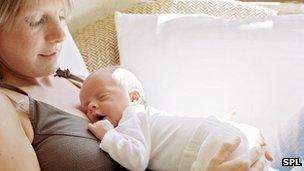Home birth complications 'less common' than hospital
- Published

In the UK, home births account for around 2.5% of all births - the figure is 20% in the Netherlands
Planned home births are less risky than planned hospital births, particularly for second-time mothers, says research in the British Medical Journal.
A large Dutch study, external found the risk of severe complications to be one in 1,000 for home births and 2.3 in 1,000 for hospital births.
The Royal College of Midwives said the study was further evidence of the safety and benefits of home birth.
Obstetricians warn that the system in the Netherlands is different to the UK.
For low-risk women having their first baby at home, the study calculated their risk of being admitted to intensive care or needing a large blood transfusion to be small - and similar to women giving birth in hospital.
This was 2.3 per 1,000 for home births, compared with 3.1 per 1,000 for planned hospital births.
But in women who had given birth before, severe complications were found to be less common during planned home births.
The researchers, including midwives and obstetricians from universities in Amsterdam, Leiden and Nijmegen, said those figures were "statistically significant".
In this group of women, the risk of severe blood loss after delivery (also known as postpartum haemorrhage) was 19.6 per 1,000 for a planned home birth compared with 37.6 per 1,000 for planned hospital births.
In the study of nearly 150,000 low-risk women in the Netherlands who gave birth between 2004 and 2006, 92,333 had a planned home birth and 54,419 had a planned hospital birth.
Home births in the Netherlands account for around 20% of all births. Currently in the UK, 2.4% of births are planned at home, down from 3% in 2008.
'Good system'
Ank de Jonge, a practising midwife and senior researcher on the study from the VU University Medical Centre in Amsterdam, said their findings showed that the system in the Netherlands was working well.
But she emphasised that this depended on a number of different factors.
"This comes from a good risk selection system, good transport in place and well-trained midwives."
She also warned that in emergencies the right facilities had to be in place.

Home births are particularly suited to low-risk women having their second or third baby
"Women who give birth at home are less likely to have interventions at home, but if there is a serious problem there should be a good system to deal with them."
The study said, "Every avoidable adverse maternal outcome is one too many," and should lead to improvements in maternity care.
The safety of planned home births is a subject of continuous debate.
A 2011 BMJ study of 65,000 English births found that home birth carried a higher risk for the babies of first-time mothers - but for second-time mothers giving birth there was no difference in the risk to babies between home, a midwife-led unit or a doctor-led hospital unit, it said.
The same study found that women who planned to give birth at home were less likely to need a Caesarean section or a forceps delivery.
Providing choice
Cathy Warwick, chief executive of the Royal College of Midwives, said the research was proof of the safety and benefits of home birth for some women, particularly those who have given birth before, and showed that they could save the NHS money.
"This research should be encouraging providers and commissioners of maternity services to put more resources into providing women with a real choice of having a home birth, because at present we know many women who would want one often cannot have one because of a lack of midwives.
"Providing choice of place of birth is at the heart of the government's agenda so it was disappointing that last year saw a drop in home births."
She added: "We should be aiming to see home births at the levels of the 1960s when a third of women had their babies in their homes."
Dr Tony Falconer, President of the Royal College of Obstetricians and Gynaecologists, said national differences had an impact on the services available to women.
"The rate of home birth in the UK is low in comparison to the Netherlands where the proximity to specialist services with short transfer times is the norm.
"The same advantages are not always available across the UK, so the safety of home birth has to be considered in the context of the availability of local services."
He said that the RCOG supported the choice of a home birth for low-risk women expecting a second or third baby.
"Our High Quality Women's Health Care report emphasised the need for a reorganisation of women's health services around clinical networks. There is a greater need for more services to be provided in the community for low-risk women.
"For more complex cases, women need access to units providing 24-hour consultant cover."
- Published19 April 2012
- Published25 November 2011
- Published28 April 2013